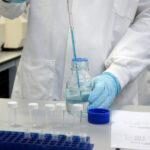Targeting Tumour Cells
From revealing new insights into basic cell biology to realising new therapeutic strategies that target malignant cells with precision, our laboratory research will continue to explore innovative therapeutic options, some of which have already reached clinical trials.
Theme Leads: Professor John F. Marshall, Professor Tyson V. Sharp
Key Cancer Types: breast, lung, pancreatic
Understanding the basic biology of cancer – how it arises, eludes normal controls and orchestrates normal cells to collude in its ability to spread – is the bedrock of our cancer research because here lies the means to beat cancer. Our basic biology research has led to novel discoveries and has paved the way to potential new therapeutics.
Our recent discovery and development of a novel radiotracer for the cancer-associated integrin, avb6, has led to clinical trials in fibrosis and cancer. In addition, the discovery of the essential need for extracellular arginine by multiple cancer types has developed into several successful clinical trials.
In fact, our excellent success in targeting the metabolism will be enhanced once we appoint a new Professor of Cancer Metabolism in the coming year.
Additionally, current studies of LIMD-1 have identified sensitive signalling pathways in cancers deficient in this protein and we are currently validating the first targeted therapy for LIMD-1-negative lung cancers, which make up approximately 47% of lung adenocarcinomas and therefore may represent a significant new therapeutic option for a large number of patients with lung cancer. Current preclinical work is underway with the hope that this new drug will be in Phase II clinical trials soon.
We have also identified synthetic lethal interactions with loss of DNA mismatch repair genes in a range of tumour types and also loss of the metabolic enzyme ASS1 in mesothelioma. These synthetic lethal interactions represent novel means of therapeutically targeting specific subsets of a number of hard-to-treat cancers.
Furthermore, we have uncovered a novel adaptation mechanism that permits centrosome amplification in epithelial cancers: Loss of E-cadherin allows survival of cells with extra centrosomes. These findings will be used to develop biomarkers to identify patients that are sensitive to therapies that target cancer cells with extra centrosomes.
- We opened two clinical trials, one for breast cancer (IMETAB6 – Imaging of metastatic breast cancer by radioimaging integrin avb6) and one for non-small cell lung cancer (iTRAP – Tumours Requiring Arginine to Assess ADI-PEG 20 With Atezolizumab, Pemetrexed and Carboplatin)
- We attracted over £1.6M for additional research projects and won a PCUK programme to develop CAR-T cell therapy of pancreatic cancer
- With the support of the SMD metabolism group, we also secured funding to purchase a dedicated MS that will be used for metabolic flux analysis. This approach will allow us to investigate how cancer cells remodel their metabolism and thus identify new therapeutic targets.
Therapeutic targeting of integrin αvβ6 in breast cancer. Moore KM et al.,(28 authors), Marshall JF (last author). J Natl Cancer Inst (2014) 106(8). PMID: 24974129
A direct role for Met endocytosis in tumorigenesis. Joffre C, Barrow R, Ménard L, Calleja V, Hart IR, Kermorgant S. Nat Cell Biol (2011) 13(7):827-837. PMID: 21642981
Receptor tyrosine kinase c-Met controls the cytoskeleton from different endosomes via different pathways. Menard L, Parker PJ, Kermorgant S. Nat Commun (2014) 5:3907. PMID: 24835487
Empirical inference of circuitry and plasticity in a kinase signalling network. Wilkes EH, Terfve C, Gribben JG, Saez-Rodriguez J, Cutillas P. Proc Natl Acad Sci USA (2015) 112(25):7719-7724. PMID: 26060313
Nuclear translocation of FGFR1 and FGF2 in pancreatic stellate cells facilitates pancreatic cancer cell invasion. Coleman SJ, Chioni AM, Ghallab M, Anderson RK, Lemoine NR, Kocher HM, Grose RP. EMBO Mol Med (2014) 6(4):467-481. PMID: 24503018
Metabolic response to pegylated arginine deiminase in mesothelioma with promoter methylation of argininosuccinate synthetase. Szlosarek PW, Luong P, Phillips MM, Baccarini M, Stephen E, Szyszko T, Sheaff MT, Avril N. J Clin Oncol (2013) 31(7):e111-113. PMID: 23319692
The LIMD1 protein bridges an association between the prolyl hydroxylases and VHL to repress HIF-1 activity. Foxler DE et al. (14 authors), Sharp TV (last author). Nat Cell Biol (2012) 14(2):201-208. PMID: 22286099
Intracellular autofluorescence: a biomarker for epithelial cancer stem cells. Miranda-Lorenzo I et al. (16 authors), Heeschen C (last author). Nat Methods (2014) 11(11):1161-1169. PMID: 25262208
The miR-17-92 cluster counteracts quiescence and chemoresistance in a distinct subpopulation of pancreatic cancer stem cells. Cioffi M et al. (13 authors), Heeschen C (last author). Gut (2015) 64(12):1936-1948. PMID: 25887381
MYC/PGC-1α Balance Determines the Metabolic Phenotype and Plasticity of Pancreatic Cancer Stem Cells. Sancho P et al. (14 authors), Heeschen C (last author). Cell Metab (2015) 22(4):590-605. PMID: 26365176
Image credit: Human oral squamous cell carcinoma cell, SEM. Anne Weston, LRI, CRUK and John Marshall, Tumour Biology Lab. CC BY-NC




